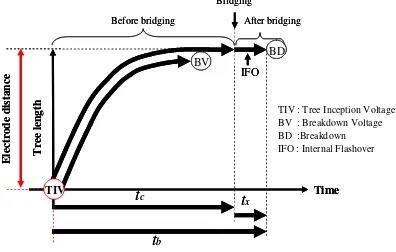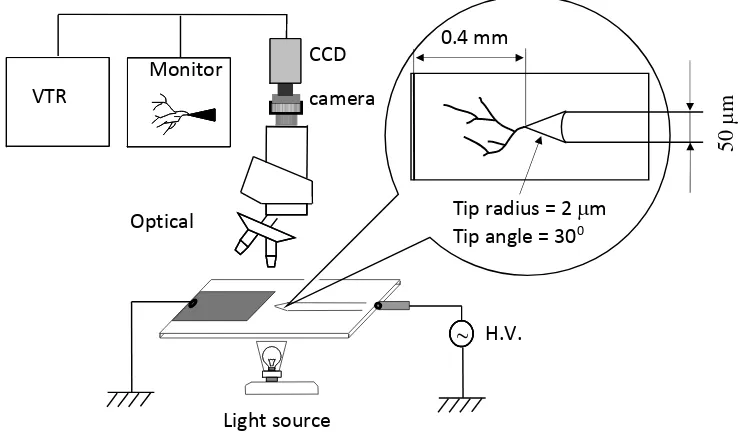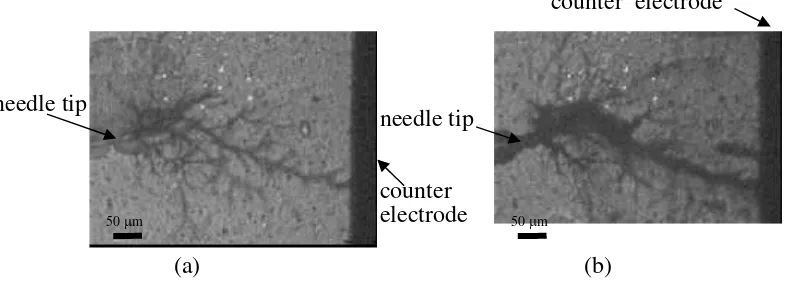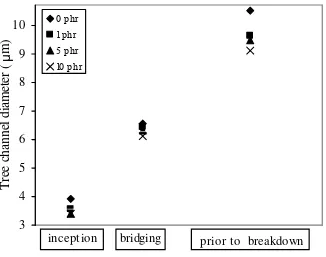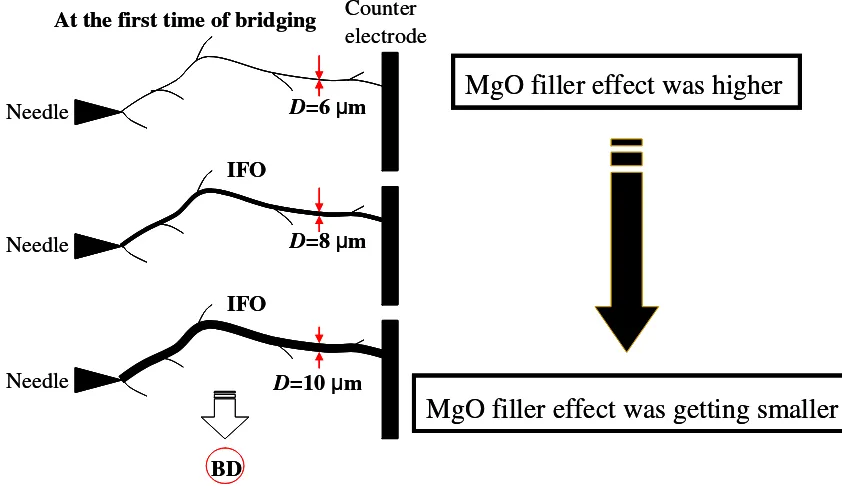The Effect of Mgo Nano Filler Mixture On The Visual Aspects of Treeing Breakdown in Ldpe Based Composite
Rudi Kurnianto
Department of Electrical Engineering, Tanjungpura University
ABSTRACT
This paper deals with a nano-composite of magnesium oxide (MgO) added to a low-density polyethylene (LDPE) which was subjected to an electrical treeing breakdown investigation. When voltage application was set exactly at the inception level, even the tree had bridged the specimen the breakdown was not always immediately to occur. There would be so-called time-lag between “bridging” and “final breakdown”. The LDPE with MgO excelled to suppress the increase of tree parameters than that of LDPE without MgO. It is considered that the polymer nano-composite is more resistive against partial discharge and then electrical treeing than their base material.
Keywords : Nano, composite, MgO filler, LDPE, Electrical Treeing, Inception, Breakdown, Internal Flashover, Time-lag
INTRODUCTION
Since power apparatus are recently being wight reduced and downsized in
order to reduce power transmission costs; the compact design of high quality of
composite material with nano-filler has become attractive [1-3]. As for LDPE, which
is widely used for cable insulations, a nano-composite material of MgO added to
LDPE is the most attractive material to be investigated nowadays. One of the
important electrical properties in insulations is the treeing breakdown mechanism.
Electrical trees consist of connected channels few micrometers in diameter, with
branches tens of micrometers long. The walls of the channels are not always
carbonized and only weakly conducting; thus although a short circuit may occur if
the tree bridges the insulation [4], this is not always immediately the case. However,
it is also possible for a breakdown to be initiated before electrical trees completely
bridge the insulation [5]. Thus, the runaway stage of final brekakdown mechanisms
of electrical trees could be either “visual” or “not visual” aspect [6]. It is not so easy
to discriminate experiment to investigate these mechanisms when will it become
visual, and when will it not become visual aspect. In the previous paper [7, 8],
classification of both visual and not visual aspects of final breakdown mechanisms
investigated by breakdown voltage using large applied voltage compared to the
inception voltage. Visual aspect was investigated using applied voltage which lied
exactly at the inception voltage. It was suppossed that the higher voltage above their
inception level is applied, the higher tendency of final breakdown to change from
visual to be not visual aspect. The results are sketched as in Figure 1.
Figure 1. Sketch of Treeing Breakdown Mechanisms
Time to breakdown (tb) is the sum of the time the tree needs to bridge the
counter electrode (tc) and time-lag to breakdown (tx).
The recent paper is a digest on the visual aspect of final breakdown
mechanisms after tree bridged the counter electrode.
EXPERIMENTAL
Specimen
In the present study, 150 m thick leaf-like specimens were used. This
specimen is powerfull for electrical treeing expreiments, because it coud be easily
modified according to the experimental intend and enable visually observe the tree
inception and propagation until breakdown. A tungsten wire with 50 m in diameter
radius was 2 m. The tungsten needle was sandwitched in between two
nano-composite films (80m in each thickness) and hot-pressed down to about 150m in
thickness. The specimen sheet was fixed between a slide glass and a cover glass by
Aron Alfa adhesive (Toa Gosei Ltd.). Aluminium foil was applied as a counter
electrode at a distance of 0.4 mm from the tip of tungsten needle. The leaf-like
specimens were prepared with various concentrations of MgO fillers; 0, 1, 5, and 10
phr (parts per hundreds ratio).
Breakdown Test
A schematic diagram of measuring system is shown in Figure 2.
Figure 2. Tree Observation System
An ac ramp voltage of 60 Hz was applied between the needle and counter
electrode at a continuous rising speed (0.5 kV/s), however, as soon as tree had been
observed, the voltage was kept at the constant value to observe the tree propagation
until bridging the counter electrode and leading to final breakdown. It was recorded
by VTR (video tape recorder) through CCD (charge couple device) camera that
mounted on the microscope. The tree inception voltage was defined as the voltage
when the tree length observed by CCD camera had exceeded 10 m [5]. When
CCD
camera
Optical
microscope Monitor VTR
0.4 mm
Tip radius = 2m Tip angle = 300
50
m
Light source
applying voltage, the specimens were placed in a vessel filled with silicone oil of 10
mm2/s (10 cSt) in viscousity to avoid surface flashover. All tests are carried out
under ambient temperature.
RESULTS AND DISCUSSION
Based on the observation, after about several minutes depending on the filler
concentrations, the tree arrived at the counter electrode and stopped the growth at
there. However, even the tree had bridged the counter electrode; the breakdown was
not immediately to occur. There was time-lag between “bridging” and “final
breakdown”. During this period of time-lag, as the active tree channel had bridged
the counter electrode, the partial discharges occured in this channel. It occurence
could be seen clearly as a very bright light (just like lightning strike in the nature)
from the needle tip towards the counter electrode. It is called as internal flashover.
The tree channels were eroded by this internal flashover. Figure 3 shows the
photogrpah of tree propagation when it bridged the counter electrode at the first time
(a) and then just prior to the final breakdown in (b).
(a) (b)
Figure 3. Photograph of Tree Propagation When it Bridged The Counter Electrode at the First Time (a), and Then Just Prior to the Final Breakdown in (b).
By comparing Figure. 3 (a) and (b), it is seen that the tree channel become
thicker as the internal flashover occurence more intense. There would be several
internal flashover occurences before the specimens were completely broken down.
The change of diameter of trees growth in the composite with various concentration
of nano-filler is shown more detail in Figure. 4. counter electrode needle tip
50m
counter electrode
needle tip
Figure 4. Comparison of Tree Channel Diameter Changes From Inception, First Time of Bridging and Just Prior to Final Breakdown under Various MgO Concentration.
The effect of MgO filler on the time to bridging and breakdown, time-lag to
breakdown and internal flashover rate are shown in Table 1 below.
Tabel 1
Filler Effect on Treeing Parameters
Tree Parameters 0 phr 1 phr 5 phr 10 phr
Time to bridging (min) 3.84 5.13 8.15 10.51
Time to breakdown (min.) 5.27 7.11 10.32 14.57
Time-lag to breakdown (min.) 0.78 1.51 2.23 4.39
Internal flashover rate (number/min.) 58.11 9.85 6.88 2.15
The time to bridging, time to breakdown and time-lag to breakdown increased
with increasing MgO concentration in LDPE.
The incorporation of nano-filler MgO tends to longer time-lag since the nano
particle would increase the electron affinities in the tree channel wall and finally
could significantly restrain the occurence of internal flashover during this period, as
illustrated in Figure. 5.
Figure 5. Illustration of MgO filler effect on the Tree Channel Changes After Bridging the Counter Eletrode.
At the low diameter (D = 6 m) the effect of filler would be significant in
restraining the internal flashover (IFO). If the occurence of internal flashover more
intense, the tree diameter will getting wider. And according to the simulated tree
propagation and finally the life time of insulations.
CONCLUSIONS
Effect of MgO nano-filler mixture on the visual aspect of treeing breakdown
in LDPE based composite has been studied. The main results are summarized as
follow.
Even the tree had bridged the specimen; the breakdown was not immediately
to occur. There was time-lag between “bridging” and “final breakdown”. During the
time-lag, the tree channel were eroded by the occurence of internal flashover in it.
MgO filler effect was higher
MgO filler effect was getting smaller
BD At the first time of bridging
Needle
MgO filler effect was getting smaller
BD At the first time of bridging
Needle
Needle
Needle
The more nano-filler concentration, the longer times needed to make tree channel
diameter thicker enough for breakdown to occur. The time-lag to treeing breakdown
characteristics of LDPE could be significantly improved by adding a few percents of
nano size MgO filler, which is very beneficial for tree aging performance of polymer
nano-composite materials.
DAFTAR PUSTAKA
1. T. Tanaka, G.C. Montanari and R. Mulhaupt : “Polymer Nanocomposites as
Dielectrics and Electrical Insulation-Perspective for Processing Technologies, Material Characterization and Future Application”, IEEE Trans. on Diel. And El. Insul., Vol.11, No.5, pp.763-784, 2004.
2. T. Tanaka, M. Kozako, N. Fuse and Y. Ohki : “Proposal of a Multi-core Model
for Polymer Nanocomposite Dielectrics”, IEEE Trans. On Diel. And El. Insul., Vol.12, No.4, pp.669-681, 2005.
3. Y. Murata, Y. Sekiguchi, Y. Inoue and M. Kanaoka : “Investigation of Electrical
Phenomena of Inorganic-filler/LDPE Nanocomposite Material”, Proc. of 2005 ISEIM, P2-3, pp.650-653, 2005.
4. Budenstein P.P. : IEEE Trans. Electr. Insul., EI-15, pp.225-240, 1980.
5. L. A. Dissado and J. C. Fothergill : “Electrical Degradation and Breakdown in Polymers”, pp.57-58, 120, G. C. Steven, Ed., Peter Peregrinus, London, 1992.
6. N. Hozumi, H. Michiue, H. Nagae, Y. Muramoto and M. Nagao : “Time-lag Measurement of Void Discharges for the Clarification of the Factor for Partial Discharges Pattern”, Annu. Rep. Conf. Electr. Insul. & Dielectr. Phenomenon
(CEIDP), #7C-7, pp. 717-720, Victoria, Canada, 2000.
7. R. Kurnianto, Y. Murakami, N. Hozumi, M. Nagao and Y. Murata : Proc. Of CEIDP (06CH37829), pp.373-376, Kansas City, USA, 2006.
